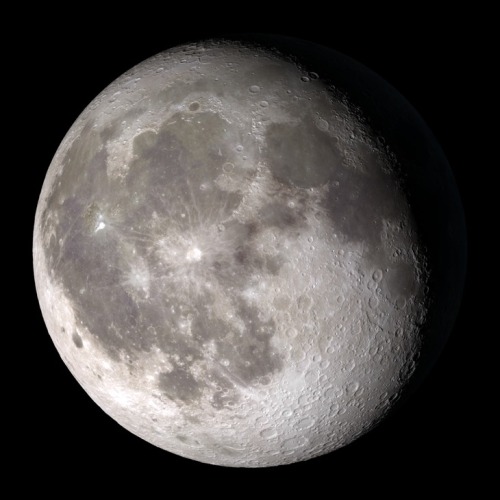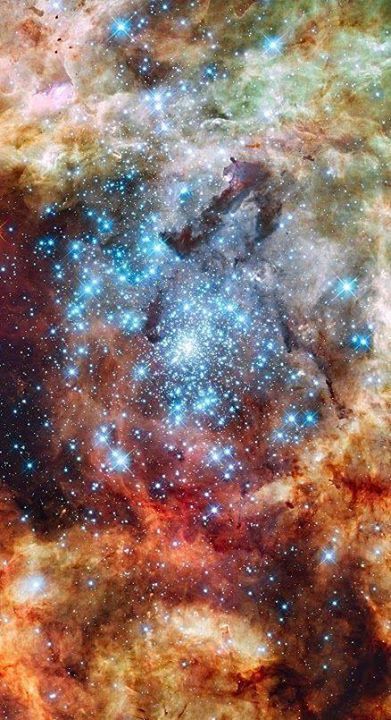The Moon In Motion
The Moon in Motion
Happy New Year! And happy supermoon! Tonight, the Moon will appear extra big and bright to welcome us into 2018 – about 6% bigger and 14% brighter than the average full Moon. And how do we know that? Well, each fall, our science visualizer Ernie Wright uses data from the Lunar Reconnaissance Orbiter (LRO) to render over a quarter of a million images of the Moon. He combines these images into an interactive visualization, Moon Phase and Libration, which depicts the Moon at every day and hour for the coming year.

Want to see what the Moon will look like on your birthday this year? Just put in the date, and even the hour (in Universal Time) you were born to see your birthday Moon.
Our Moon is quite dynamic. In addition to Moon phases, our Moon appears to get bigger and smaller throughout the year, and it wobbles! Or at least it looks that way to us on Earth. This wobbling is called libration, from the Latin for ‘balance scale’ (libra). Wright relies on LRO maps of the Moon and NASA orbit calculations to create the most accurate depiction of the 6 ways our Moon moves from our perspective.
1. Phases

The Moon phases we see on Earth are caused by the changing positions of the Earth and Moon relative to the Sun. The Sun always illuminates half of the Moon, but we see changing shapes as the Moon revolves around the Earth. Wright uses a software library called SPICE to calculate the position and orientation of the Moon and Earth at every moment of the year. With his visualization, you can input any day and time of the year and see what the Moon will look like!
2. Shape of the Moon

Check out that crater detail! The Moon is not a smooth sphere. It’s covered in mountains and valleys and thanks to LRO, we know the shape of the Moon better than any other celestial body in the universe. To get the most accurate depiction possible of where the sunlight falls on the lunar surface throughout the month, Wright uses the same graphics software used by Hollywood design studios, including Pixar, and a method called ‘raytracing’ to calculate the intricate patterns of light and shadow on the Moon’s surface, and he checks the accuracy of his renders against photographs of the Moon he takes through his own telescope.

3. Apparent Size

The Moon Phase and Libration visualization shows you the apparent size of the Moon. The Moon’s orbit is elliptical, instead of circular - so sometimes it is closer to the Earth and sometimes it is farther. You’ve probably heard the term “supermoon.” This describes a full Moon at or near perigee (the point when the Moon is closest to the Earth in its orbit). A supermoon can appear up to 14% bigger and brighter than a full Moon at apogee (the point when the Moon is farthest from the Earth in its orbit).
Our supermoon tonight is a full Moon very close to perigee, and will appear to be about 14% bigger than the July 27 full Moon, the smallest full Moon of 2018, occurring at apogee. Input those dates into the Moon Phase and Libration visualization to see this difference in apparent size!
4. East-West Libration
Over a month, the Moon appears to nod, twist, and roll. The east-west motion, called ‘libration in longitude’, is another effect of the Moon’s elliptical orbital path. As the Moon travels around the Earth, it goes faster or slower, depending on how close it is to the Earth. When the Moon gets close to the Earth, it speeds up thanks to an additional pull from Earth’s gravity. Then it slows down, when it’s farther from the Earth. While this speed in orbital motion changes, the rotational speed of the Moon stays constant.
This means that when the Moon moves faster around the Earth, the Moon itself doesn’t rotate quite enough to keep the same exact side facing us and we get to see a little more of the eastern side of the Moon. When the Moon moves more slowly around the Earth, its rotation gets a little ahead, and we see a bit more of its western side.
5. North-South Libration

The Moon also appears to nod, as if it were saying “yes,” a motion called ‘libration in latitude’. This is caused by the 5 degree tilt of the Moon’s orbit around the Earth. Sometimes the Moon is above the Earth’s northern hemisphere and sometimes it’s below the Earth’s southern hemisphere, and this lets us occasionally see slightly more of the northern or southern hemispheres of the Moon!
6. Axis Angle

Finally, the Moon appears to tilt back and forth like a metronome. The tilt of the Moon’s orbit contributes to this, but it’s mostly because of the 23.5 degree tilt of our own observing platform, the Earth. Imagine standing sideways on a ramp. Look left, and the ramp slopes up. Look right and the ramp slopes down.
Now look in front of you. The horizon will look higher on the right, lower on the left (try this by tilting your head left). But if you turn around, the horizon appears to tilt the opposite way (tilt your head to the right). The tilted platform of the Earth works the same way as we watch the Moon. Every two weeks we have to look in the opposite direction to see the Moon, and the ground beneath our feet is then tilted the opposite way as well.
So put this all together, and you get this:
Beautiful isn’t it? See if you can notice these phenomena when you observe the Moon. And keep coming back all year to check on the Moon’s changing appearance and help plan your observing sessions.
Follow @NASAMoon on Twitter to keep up with the latest lunar updates.
Make sure to follow us on Tumblr for your regular dose of space: http://nasa.tumblr.com.
More Posts from Starsglaxiesspace and Others










❤️😭😊😍


The prominent ridge of emission featured in this vivid skyscape is designated IC 5067. Part of a larger emission region with a distinctive shape, popularly called The Pelican Nebula, the ridge spans about 10 light-years and follows the curve of the cosmic pelican’s head and neck. https://go.nasa.gov/2hiMiLy

Dragon Attached to Station for Month of Cargo Transfers
SpaceX - CRS-13 Dragon Mission patch. Dec. 17, 2017
Image above: The Dragon resupply ship is pictured just 10 meters away from the space station’s Canadarm2. Image Credit: NASA TV. The SpaceX Dragon cargo spacecraft was installed on the Harmony module of the International Space Station at 8:26 a.m. EST. The 13th contracted commercial resupply mission from SpaceX (CRS-13) delivered more than 4,800 pounds of supplies and payloads to the station. Among the research materials flying inside Dragon’s pressurized area, one investigation will demonstrate the benefits of manufacturing fiber optic filaments in a microgravity environment. Designed by the company Made in Space, and sponsored by the Center for the Advancement of Science in Space (CASIS), the investigation will attempt to pull fiber optic wire from ZBLAN, a heavy metal fluoride glass commonly used to make fiber optic glass. Results from this investigation could lead to the production of higher-quality fiber optic products for use in space and on Earth.
U.S. Commercial Cargo Ship Arrives at the Space Station
Dragon is scheduled to depart the station in January 2018 and return to Earth with more than 3,600 pounds of research, hardware and crew supplies. Loaded with some three tons of experiments and supplies, the SpaceX Dragon cargo craft arrived at the International Space Station Dec. 17, where Expedition 53 crew members Mark Vande Hei and Joe Acaba of NASA captured it by using the Canadian-built robotic arm.
Image above: Dec. 17, 2017: International Space Station Configuration. Four spaceships are parked at the space station including the SpaceX Dragon space freighter, the Progress 67 and 68 resupply ships and the Soyuz MS-06 crew ship. Image Credit: NASA TV. Ground controllers at NASA’s Johnson Space Center in Houston took over after Dragon was grappled, sending commands to maneuver the ship to the Earth-facing side of the Harmony module where it was attached for a month-long stay. Dragon was launched Dec. 15 on the SpaceX Falcon 9 rocket from Complex 40 at the Cape Canaveral Air Force Station in Florida to begin its journey to the international outpost. Related links: Debris Sensor (SDS): https://www.nasa.gov/mission_pages/station/research/experiments/2145.html Center for the Advancement of Science in Space (CASIS): http://www.iss-casis.org/ Total and Spectral Solar Irradiance Sensor, or TSIS-1: http://www.nasa.gov/tsis-1 SpaceX: http://www.nasa.gov/spacex Commercial Resupply: http://www.nasa.gov/mission_pages/station/structure/launch/index.html Expedition 54: https://www.nasa.gov/mission_pages/station/expeditions/future.html International Space Station (ISS): https://www.nasa.gov/mission_pages/station/main/index.html Images (mentioned), Video (NASA TV), Text, Credits: NASA/Mark Garcia. Greetings, Orbiter.ch Full article


The NASA/ESA Hubble Space Telescope has captured the sharpest view yet of the most famous of all planetary nebulae: the Ring Nebula (M57).One of the most famous of all planetary nebulae. A dying star has thrown off some of its outer material thousands of years ago. The nebula is situated 2.000 light years away in the constellation Lyra. http://bit.ly/2z7rLRS
![[OC] SpaceX ZUMA Liftoff - Album In Comments (6000x4000)](https://64.media.tumblr.com/51e6d2a10ae6ede4e140760fba65f7cc/tumblr_p281l3VP0t1ve10t6o1_500.jpg)
[OC] SpaceX ZUMA Liftoff - album in comments (6000x4000)

-
 daieuxetdailleurs liked this · 2 years ago
daieuxetdailleurs liked this · 2 years ago -
 eddyrocksteady-blog liked this · 2 years ago
eddyrocksteady-blog liked this · 2 years ago -
 don-omar-78 liked this · 3 years ago
don-omar-78 liked this · 3 years ago -
 inconstantsearchofperfection reblogged this · 3 years ago
inconstantsearchofperfection reblogged this · 3 years ago -
 glass-handle-with-care reblogged this · 4 years ago
glass-handle-with-care reblogged this · 4 years ago -
 olfamannai liked this · 4 years ago
olfamannai liked this · 4 years ago -
 maricynicmonyet liked this · 4 years ago
maricynicmonyet liked this · 4 years ago -
 bgukfan liked this · 4 years ago
bgukfan liked this · 4 years ago